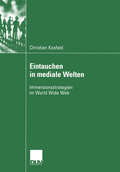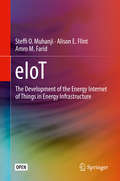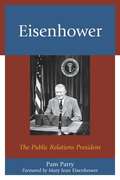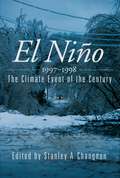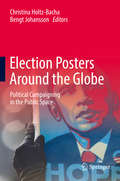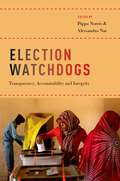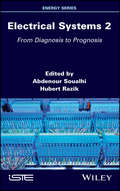- Table View
- List View
Einigkeitsdiskurse: Zur Inszenierung von Konsens in organisationaler und öffentlicher Kommunikation (Kommunikation in Organisationen)
by Stephan Habscheid Clemens KnoblochEinsatz von Social Software durch Unternehmensberater: Akzeptanz, Präferenzen, Nutzungsarten
by Malte MartensenMalte Martensen untersucht die berufliche Nutzung von Social Software aus verhaltenswissenschaftlicher Perspektive. Im Zentrum der Arbeit steht die Frage, wie und wofür Social Software im organisationalen Rahmen eingesetzt wird und welche Faktoren einen Einfluss auf die Nutzungsakzeptanz haben. Unternehmensberater stehen als Vertreter einer wissensintensiven und innovationsaffinen Branche im Fokus der Betrachtung. Gruppenvergleiche anhand von sozio-demografischen Faktoren führen zu Ergebnissen, die für Wissenschaft und Praxis von hoher Relevanz sind. Die abgeleiteten Nutzungsprofile sind besonders für Unternehmen, die Social Software zielgruppengerecht einführen wollen, von Bedeutung.
Eintauchen in mediale Welten: Immersionsstrategien im World Wide Web (Kommunikationswissenschaft)
by Christian KosfeldChristian Kosfeld nimmt eine systematische Untersuchung medialer Erscheinungen vor, um Erkenntnisse über das Phänomen Immersion zu gewinnen. Trotz der Subjektbestimmtheit der immersiven Erfahrung weist er anhand einer phänomenologischen Analyse dreier Websites Strukturen und Funktionsprinzipien immersiver Medienangebote nach.
eIoT: The Development of the Energy Internet of Things in Energy Infrastructure
by Steffi O. Muhanji Alison E. Flint Amro M. FaridThis open access book explores the collision between the sustainable energy transition and the Internet of Things (IoT). In that regard, this book’s arrival is timely. Not only is the Internet of Things for energy applications, herein called the energy Internet of Things (eIoT), rapidly developing but also the transition towards sustainable energy to abate global climate is very much at the forefront of public discourse. It is within the context of these two dynamic thrusts, digitization and global climate change, that the energy industry sees itself undergoing significant change in how it is operated and managed. This book recognizes that they impose five fundamental energy management change drivers: 1.) the growing demand for electricity, 2.) the emergence of renewable energy resources, 3.) the emergence of electrified transportation, 4.) the deregulation of electric power markets, 5.) and innovations in smart grid technology. Together, they challenge many of the assumptions upon which the electric grid was first built. The goal of this book is to provide a single integrated picture of how eIoT can come to transform our energy infrastructure. This book links the energy management change drivers mentioned above to the need for a technical energy management solution. It, then, describes how eIoT meets many of the criteria required for such a technical solution. In that regard, the book stresses the ability of eIoT to add sensing, decision-making, and actuation capabilities to millions or perhaps even billions of interacting “smart" devices. With such a large scale transformation composed of so many independent actions, the book also organizes the discussion into a single multi-layer energy management control loop structure. Consequently, much attention is given to not just network-enabled physical devices but also communication networks, distributed control & decision making, and finally technical architectures and standards. Having gone into the detail of these many simultaneously developing technologies, the book returns to how these technologies when integrated form new applications for transactive energy. In that regard, it highlights several eIoT-enabled energy management use cases that fundamentally change the relationship between end users, utilities, and grid operators. Consequently, the book discusses some of the emerging applications for utilities, industry, commerce, and residences. The book concludes that these eIoT applications will transform today’s grid into one that is much more responsive, dynamic, adaptive and flexible. It also concludes that this transformation will bring about new challenges and opportunities for the cyber-physical-economic performance of the grid and the business models of its increasingly growing number of participants and stakeholders.
Eisenhower: The Public Relations President (PDF)
by Pam Parry Mary Jean EisenhowerIn the 1950s, public relations practitioners tried to garner respectability for their fledgling profession, and one international figure helped in that endeavor. President Dwight D. Eisenhower embraced public relations as a necessary component of American democracy, advancing the profession at a key moment in its history. But he did more than believe in public relations-he practiced it. Eisenhower changed how America campaigns by leveraging television and Madison Avenue advertising. Once in the Oval Office, he maximized the potential of a new medium as the first U.S. president to seek training for television and to broadcast news conferences on television. Additionally, Eisenhower managed the news through his press office, molding the role of the modern presidential press secretary. The first president to adopt a policy of full disclosure on health issues, Eisenhower survived (politically as well as medically) three serious illnesses while in office. The Eisenhower Administration was the most forthcoming on the president's health at the time, even though it did not always live up to its own policy. In short, Eisenhower deserves credit as this nation's most innovative public relations president, because he revolutionized America's political communication process, forever changing the president's relationship with the Fourth Estate, Madison Avenue, public relations, and ultimately, the American people.
EKC 2009 Proceedings of EU-Korea Conference on Science and Technology (Springer Proceedings in Physics #135)
by Joung Hwan Lee Habin Lee Jung-Sik KimCurrent research fields in science and technology were presented and discussed at the EKC2008, informing about the interests and directions of the scientists and engineers in EU countries and Korea. The Conference has emerged from the idea of bringing together EU and Korea to get to know each other better, especially in fields of science and technology. The focus of the conference is put on the topics: Computational Fluid Dynamics, Mechatronics and Mechanical Engineering, Information and Communications Technology, Life and Natural Sciences, Energy and Environmental Technology.
EKC2008 Proceedings of the EU-Korea Conference on Science and Technology (Springer Proceedings in Physics #124)
by Seung-Deog YooCurrent research fields in science and technology were presented and discussed at the EKC2008, informing about the interests and directions of the scientists and engineers in EU countries and Korea. The Conference has emerged from the idea of bringing together EU and Korea to get to know each other better, especially in fields of science and technology. The focus of the conference is put on the topics: Computational Fluid Dynamics; Mechatronics and Mechanical Engineering; Information and Communications Technology; Life and Natural Sciences; Energy and Environmental Technology.
EKC2010: Proceedings of the EU-Korea Conference on Science and Technology (Springer Proceedings in Physics #138)
by Man-Wook Han Jehyun LeeCurrent research fields in science and technology were presented and discussed at the EKC2009, informing about the interests and directions of the scientists and engineers in EU countries and Korea. The Conference has emerged from the idea of bringing together EU and Korea to get to know each other better, especially in fields of science and technology.
El léxico-gramática del español: Una aproximación mediante la lingüística de corpus
by Alan V. Brown Yanira B. Paz Earl Kjar BrownEl léxico-gramática del español ofrece una aproximación alternativa al estudio de la gramática avanzada del español. Este libro brinda al estudiante un enfoque auténtico y contextualizado del uso del español, basándose en datos provenientes de corpus de español-L1 y L2 junto a la investigación lingüística a fin de describir las características léxico-gramaticales fundamentales de la lengua y su variación. Cada capítulo incluye actividades guiadas para que los estudiantes puedan realizar búsquedas en estos corpus con el propósito de llegar a conclusiones fundamentadas en evidencias empíricas sobre cómo los aprendices de varios niveles de competencia usan ciertos elementos léxico-gramaticales. Este libro representa un recurso ideal para los estudiantes de la gramática avanzada del español a nivel de pregrado y posgrado. El léxico-gramática del español provides an alternative approach to the study of advanced Spanish grammar. Drawing on L1 and L2 Spanish language corpora and linguistic research to describe key lexico-grammatical characteristics of the Spanish language, this book gives students insight into real, variable, and contextualized usage of Spanish. Each chapter includes guided exercises so that students can conduct their own searches of the corpus and draw evidence-based conclusions on how particular grammar structures are used by Spanish speakers at varying levels of proficiency. This is an ideal resource for advanced undergraduate and postgraduate students of Spanish language and linguistics.
El léxico-gramática del español: Una aproximación mediante la lingüística de corpus
by Alan V. Brown Yanira B. Paz Earl Kjar BrownEl léxico-gramática del español ofrece una aproximación alternativa al estudio de la gramática avanzada del español. Este libro brinda al estudiante un enfoque auténtico y contextualizado del uso del español, basándose en datos provenientes de corpus de español-L1 y L2 junto a la investigación lingüística a fin de describir las características léxico-gramaticales fundamentales de la lengua y su variación. Cada capítulo incluye actividades guiadas para que los estudiantes puedan realizar búsquedas en estos corpus con el propósito de llegar a conclusiones fundamentadas en evidencias empíricas sobre cómo los aprendices de varios niveles de competencia usan ciertos elementos léxico-gramaticales. Este libro representa un recurso ideal para los estudiantes de la gramática avanzada del español a nivel de pregrado y posgrado. El léxico-gramática del español provides an alternative approach to the study of advanced Spanish grammar. Drawing on L1 and L2 Spanish language corpora and linguistic research to describe key lexico-grammatical characteristics of the Spanish language, this book gives students insight into real, variable, and contextualized usage of Spanish. Each chapter includes guided exercises so that students can conduct their own searches of the corpus and draw evidence-based conclusions on how particular grammar structures are used by Spanish speakers at varying levels of proficiency. This is an ideal resource for advanced undergraduate and postgraduate students of Spanish language and linguistics.
El Niño 1997-1998: The Climate Event of the Century
by Stanley A. ChangnonThis book will cover the time span from the first indications of El Nino (May 1997) until its reversal (June 1998). The focus will be largely on the United States, where El Nino produced widespread changes in how the public perceives weather and in the accuracy of forecasts Among the key issues it will examine are how the news media interpreted and dramatixed El Nino and the reaction both of the public and decision-makers (the latter based on interviews with agribusiness, utilities, water management agencies, etc.); the scientific issues emerging from the event; and the social and economic consequences of the event. Finally, it will suggest what can and should be done when El Nino occurs in the future.
Elastic Optical Networks: Architectures, Technologies, and Control (Optical Networks)
by Víctor López Luis VelascoThis book presents advances in the field of optical networks - specifically on research and applications in elastic optical networks (EON). The material reflects the authors’ extensive research and industrial activities and includes contributions from preeminent researchers and practitioners in optical networking. The authors discuss the new research and applications that address the issue of increased bandwidth demand due to disruptive, high bandwidth applications, e.g., video and cloud applications. The book also discusses issues with traffic not only increasing but becoming much more dynamic, both in time and direction, and posits immediate, medium, and long-term solutions throughout the text. The book is intended to provide a reference for network architecture and planning, communication systems, and control and management approaches that are expected to steer the evolution of EONs.
Election Politics and the Mass Press in Long Edwardian Britain (Routledge Focus on Journalism Studies)
by Christopher Shoop-WorrallThis book explores the ways in which the emergence of the ‘new’ daily mass press of the late-nineteenth and early-twentieth centuries represented a hugely significant period in histories of both the British press and the British political system. Drawing on a parallel analysis of election-time newspaper content and archived political correspondence, the author argues that the ‘new dailies’ were a welcome and vibrant addition to the mass political culture that existed in Britain prior to World War One. Chapters explore the ways in which the three ‘new dailies’ – Mail, Express, and Mirror – represented political news during the four general elections of the period; how their content intersected with, and became a part of, the mass consumer culture of pre-Great War Britain; and the differing ways political parties reacted to this new press, and what those reactions said about broader political attitudes towards the worth of ‘mass’ political communication. This book will be of interest to students and scholars of media history, British popular politics, journalism history, and media studies.
Election Politics and the Mass Press in Long Edwardian Britain (Routledge Focus on Journalism Studies)
by Christopher Shoop-WorrallThis book explores the ways in which the emergence of the ‘new’ daily mass press of the late-nineteenth and early-twentieth centuries represented a hugely significant period in histories of both the British press and the British political system. Drawing on a parallel analysis of election-time newspaper content and archived political correspondence, the author argues that the ‘new dailies’ were a welcome and vibrant addition to the mass political culture that existed in Britain prior to World War One. Chapters explore the ways in which the three ‘new dailies’ – Mail, Express, and Mirror – represented political news during the four general elections of the period; how their content intersected with, and became a part of, the mass consumer culture of pre-Great War Britain; and the differing ways political parties reacted to this new press, and what those reactions said about broader political attitudes towards the worth of ‘mass’ political communication. This book will be of interest to students and scholars of media history, British popular politics, journalism history, and media studies.
Election Posters Around the Globe: Political Campaigning in the Public Space
by Christina Holtz-Bacha Bengt JohanssonThis book examines the history and role of election posters as one of the most crucial forms of political communication, especially in electoral campaigns, in a number of countries around the globe. The contributing authors present comparative research on electoral posters from countries from all five continents, summarizing international similarities and national differences. The book also discusses theoretical aspects and different methodological approaches that are used for studying the design, content and reception of election posters as a means of political communication.
Election Watchdogs: Transparency, Accountability and Integrity
by Pippa Norris Alessandro NaiRecent decades have seen growing concern regarding problems of electoral integrity. The most overt malpractices used by rulers include imprisoning dissidents, harassing adversaries, coercing voters, vote-rigging counts, and even blatant disregard for the popular vote. Elsewhere minor irregularities are common, exemplified by inaccurate voter registers, maladministration of polling facilities, lack of security in absentee ballots, pro-government media bias, ballot miscounts, and gerrymandering. Serious violations of human rights that undermine electoral credibility are widely condemned by domestic observers and the international community. Recent protests about integrity have mobilized in countries as diverse as Russia, Mexico, and Egypt. However, long-standing democracies are far from immune to these ills; past problems include the notorious hanging chads in Florida in 2000 and more recent accusations of voter fraud and voter suppression during the Obama-Romney contest. When problems come to light, however, is anyone held to account and are effective remedies implemented? In response to these developments, there have been growing attempts to analyze flaws in electoral integrity and transparency using systematic data from cross-national time-series, forensic analysis, field experiments, case studies, and new instruments monitoring mass and elite perceptions of malpractices. This volume collects essays from international experts who evaluate the robustness, conceptual validity, and reliability of the growing body of evidence. The essays compare alternative approaches and apply these methods to evaluate the quality of elections in several areas, including the United States, Sub-Saharan Africa, and Latin America. Election Watchdogs:Transparency, Accountability and Integrity presents new insights into the importance of diverse actors who promote electoral transparency, accountability, and ultimately the integrity of electoral governance.
Election Watchdogs: Transparency, Accountability and Integrity
Recent decades have seen growing concern regarding problems of electoral integrity. The most overt malpractices used by rulers include imprisoning dissidents, harassing adversaries, coercing voters, vote-rigging counts, and even blatant disregard for the popular vote. Elsewhere minor irregularities are common, exemplified by inaccurate voter registers, maladministration of polling facilities, lack of security in absentee ballots, pro-government media bias, ballot miscounts, and gerrymandering. Serious violations of human rights that undermine electoral credibility are widely condemned by domestic observers and the international community. Recent protests about integrity have mobilized in countries as diverse as Russia, Mexico, and Egypt. However, long-standing democracies are far from immune to these ills; past problems include the notorious hanging chads in Florida in 2000 and more recent accusations of voter fraud and voter suppression during the Obama-Romney contest. When problems come to light, however, is anyone held to account and are effective remedies implemented? In response to these developments, there have been growing attempts to analyze flaws in electoral integrity and transparency using systematic data from cross-national time-series, forensic analysis, field experiments, case studies, and new instruments monitoring mass and elite perceptions of malpractices. This volume collects essays from international experts who evaluate the robustness, conceptual validity, and reliability of the growing body of evidence. The essays compare alternative approaches and apply these methods to evaluate the quality of elections in several areas, including the United States, Sub-Saharan Africa, and Latin America. Election Watchdogs:Transparency, Accountability and Integrity presents new insights into the importance of diverse actors who promote electoral transparency, accountability, and ultimately the integrity of electoral governance.
Elections and TV News in South Africa: Desperately Seeking Depth
by Bernadine JonesThis book takes television news seriously. Over the course of nine chapters, Elections and TV News in South Africa shows how six democratic South African general elections, 1994–2019, were represented on both local and international news broadcasts. It reveals the shifting narratives about South African democracy, coupled with changing and challenging political journalism practices. The book is organised in three parts: the first contains a history of South African democracy and an overview of the South African media environment. The second part is a visual analysis of the South African elections on television news, exploring portrayals of violence, security, power, and populism, and how these fit into normative news values and the ruling party’s tightening grip on the media. The final part is a conclusion, a call to action, and a suggestion to improve political journalistic practice.
Electoral Campaigns, Media, and the New World of Digital Politics
by David Taras Richard DavisToday, political leaders and candidates for office must campaign in a multimedia world through traditional forums—newspapers, radio, and television—as well as new digital media, particularly social media. Electoral Campaigns, Media, and the New World of Digital Politics chronicles how Twitter, Facebook, Reddit, email, and memes are used successfully and unsuccessfully to influence elections. Each of these platforms have different affordances and reach various audiences in different ways. Campaigns often have to wage different campaigns on each of these mediums. In some instances, they are crucial in altering coverage in the mainstream media. In others, digital media remains underutilized and undeveloped. As has always been the case in politics, outcomes that depend on economic and social conditions often dictate people’s readiness for certain messages. However, the method and content of those messages has changed with great consequences for the health and future of democracy. This book answers several questions: How do candidates/parties reach audiences that are preoccupied, inattentive, amorphous, and bombarded with so many other messages? How do they cope with the speed of media reporting in a continuous news cycle that demands instantaneous responses? How has media fragmentation altered the campaign styles and content of campaign communication, and general campaign discourse? Finally and most critically, what does this mean for how democracies function?
Electoral Politics in Sri Lanka: Presidential Elections, Manipulation and Democracy (Europa Country Perspectives)
by S. I. KeethaponcalanThis volume examines and analyses electoral politics in Sri Lanka through the theoretical framework of manipulation. The following questions guided the study: how do political actors manipulate elections, and what are the salient features of electoral politics in Sri Lanka? Primary and secondary data formed the basis of the analysis, examining eight presidential elections. The research findings indicated that Sri Lankan governments, political parties and political leaders have taken advantage of six types of electoral manipulation, including constitutional tinkering, field fixing, time fixing, vote suppression, process manipulation and resource manipulation. Through a close examination of eight presidential elections, research carried out for the volume found that elections are often associated with violence; presidential elections are mainly a majoritarian affair in which minority communities play only a marginal role; there is a significant gender imbalance, as women’s participation in the electoral process is very limited; despite the presence of a large number of candidates contesting the election, it always remains a two-way race; and amid extensive manipulation and other problems, voter participation tends to be high. This volume will be a valuable resource for students, academics and researchers who focus on democracy, good governance, electoral studies and South Asian politics and history, and will enhance the conceptual foundation of democracy advocates and activists.
Electoral Politics in Sri Lanka: Presidential Elections, Manipulation and Democracy (Europa Country Perspectives)
by S. I. KeethaponcalanThis volume examines and analyses electoral politics in Sri Lanka through the theoretical framework of manipulation. The following questions guided the study: how do political actors manipulate elections, and what are the salient features of electoral politics in Sri Lanka? Primary and secondary data formed the basis of the analysis, examining eight presidential elections. The research findings indicated that Sri Lankan governments, political parties and political leaders have taken advantage of six types of electoral manipulation, including constitutional tinkering, field fixing, time fixing, vote suppression, process manipulation and resource manipulation. Through a close examination of eight presidential elections, research carried out for the volume found that elections are often associated with violence; presidential elections are mainly a majoritarian affair in which minority communities play only a marginal role; there is a significant gender imbalance, as women’s participation in the electoral process is very limited; despite the presence of a large number of candidates contesting the election, it always remains a two-way race; and amid extensive manipulation and other problems, voter participation tends to be high. This volume will be a valuable resource for students, academics and researchers who focus on democracy, good governance, electoral studies and South Asian politics and history, and will enhance the conceptual foundation of democracy advocates and activists.
Electrical Symbols Multipage (UEB uncontracted)
by Adrian FarnsworthThis is a five-page document with a number of braille labelled images of electrical circuit symbols on each page.
Electrical Systems 2: From Diagnosis to Prognosis
by Abdenour Soualhi Hubert RazikMethods of diagnosis and prognosis play a key role in the reliability and safety of industrial systems. Failure diagnosis requires the use of suitable sensors, which provide signals that are processed to monitor features (health indicators) for defects. These features are required to distinguish between operating states, in order to inform the operator of the severity level, or even the type, of a failure. Prognosis is defined as the estimation of a system's lifespan, including how long remains and how long has passed. It also encompasses the prediction of impending failures. This is a challenge that many researchers are currently trying to address. Electrical Systems, a book in two volumes, informs readers of the theoretical solutions to this problem, and the results obtained in several laboratories in France, Spain and further afield. To this end, many researchers from the scientific community have contributed to this book to share their research results.
Electrical Systems 2: From Diagnosis to Prognosis
by Abdenour Soualhi Hubert RazikMethods of diagnosis and prognosis play a key role in the reliability and safety of industrial systems. Failure diagnosis requires the use of suitable sensors, which provide signals that are processed to monitor features (health indicators) for defects. These features are required to distinguish between operating states, in order to inform the operator of the severity level, or even the type, of a failure. Prognosis is defined as the estimation of a system's lifespan, including how long remains and how long has passed. It also encompasses the prediction of impending failures. This is a challenge that many researchers are currently trying to address. Electrical Systems, a book in two volumes, informs readers of the theoretical solutions to this problem, and the results obtained in several laboratories in France, Spain and further afield. To this end, many researchers from the scientific community have contributed to this book to share their research results.


